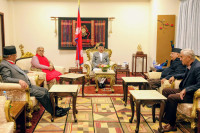Fri, Dec 26, 2025
Opinion
A game changer
Remittance can be channelled towards the creation of programmes for the economic empowerment of women
bookmark
Arshia Karki, Bikash Gupta & Needika Adhikari
Published at : February 25, 2018
Updated at : February 25, 2018 12:28
Nepal has been receiving remittances for almost two decades. It accounted for 31.75 percent of the GDP in 2015. According to a report prepared by Shodhashala for Nepal’s Ministry of Finance in 2016, about 1,500 youths leave the country daily for employment opportunities, and an estimated 6 million people are working outside the country. With the growth of migrant workers, remittances reached Rs 617 billion in the fiscal year 2014/15 which is close to the country’s budget. This amount is significantly higher than the government’s capital expenditure and foreign grants which indicates that remittances have the potential to contribute towards capital formation and enhance domestic productivity.
Formalisation of Remittance
Remittance has contributed significantly to maintain macroeconomic stability in the country. Although Nepal faces a large trade deficit, remittance has kept the balance of payments in check and has allowed the central bank to build official reserves, reducing vulnerability to external shocks. Remittance has also helped in poverty alleviation by smoothing consumption and helping households invest in human and physical capital. Despite these benefits, dependence on remittance does not provide solutions to long-term sustainable growth challenges. Remittance has mostly been used for consumption, to finance trade deficit and has been held as foreign reserves.
However, without the right mechanisms to channel remittance into productive sectors of the economy, remittance is only a temporary solution. One of the main hindrances of channelling remittances in the productive sector is the use of informal channels referred to as “hundi” to send money back to Nepal. Sending money through informal channels neither allows the monitoring of the total amount of capital entering the country nor how it is spent. Banks, financial institutions, and money transfer agencies need to lower money transfer costs to encourage the use of formal channels.
The second impediment to channel remittance into productive sectors is the lack of financial literacy programmes for migrants. Mostly unskilled workers leave for foreign countries and they are not provided with proper training before they leave. Pre-departure orientation training centres are tasked with providing prospective migrants with a two-day course on their rights and responsibilities before, during and after their departure. The course involves procedures to be taken while preparing for foreign employment, steps to ensure a safe journey and prevention of diseases, work safety, labour rights, and methods to remit money back home, but no financial education is given to migrants. Without proper training, migrants remain uneducated about savings and investment opportunities that can otherwise have long-term benefits even after their return.
The case of Siraha
As per the 2014 Nepal labour report, there are more males than females in foreign countries. For example, for every 22 labour permits that males received from the government, women just received one. This creates a high imbalance in the demographics in villages. The reliability on remittance is dangerous and unsustainable because we are at the mercy of external factors such as the state of international diplomacy. We need to diversify our economy but this will require time. In the present context, remittance must be channelled into sustainable practices such as entrepreneurship, and most importantly women entrepreneurship. This can help with: 1) women economic empowerment and 2) generating capital on its own end.
We conducted research on “access to finance,” and travelled to rural villages in Siraha to examine what financial problems women entrepreneurs were facing. The surveyed women were trained as part of the Government’s Micro-Enterprise Development Program in 2009. These women belonged to low-caste and marginalised groups.
We noticed that the villages were generally filled with elderly men, women or children. Men from these villages were in Kathmandu, India, or Gulf countries. Siraha is ranked the fifth district in terms of most labour permits granted, and is also ranked the fifth in terms of highest number of labour deaths. With the GDP of the district standing at 1/4th of Kathmandu’s, there is much to be desired. In the villages in Siraha, the conditions are deplorable.
Our objective was to assess the financial need of these trained women entrepreneurs. We found that most of these women were still poor. There were few success stories that ignited our hopes and made us feel that the programme could be expanded. “It takes six years to make an entrepreneur,” a MEDEP officer in Lahan rightly told us. We found various cases where women left their jobs, for which they were trained, after few months. Most of the reasons being that they did not have capital and resources. We could also sense a fear of uncertainty in these women—most of whom were dalits. To begin with, most of them did not have their own property. Those who had physical property feared that it would be expropriated by high castes, government officials, or that changes in the family (death) could alter their destiny. When there is fear, there are fewer incentives to engage in the market. For these women, there were many barriers.
In questionnaires, women demonstrated that they needed support in various different ways. Injection of finance at various tiers could address much of their fears. It was interesting to note that women who were relatively successful were also the ones who
travelled often and had been to banks. In villages, the bank’s sheer size and power make it a repulsive entity. However, banks are the ones that can afford to provide services that self-help groups cannot. The short-term costs may be too high for banks when counting in non-financial services that women asked for, such as business management and skill-based training, but they will be cementing an entrepreneurial culture and will have an advantage in capturing a virgin market whose growth will boost their growth.
One case that ignited hope was that of Lalita BK, living in Ratanpur village who had received training in tailoring and was looking to expand her business by learning more skills. She did not have enough money. One case that was depressing was of a dalit woman Kakulati Mahara who had lost her husband recently; devastated and financially weak, she had no option but to be a daily wage labourer.
There is a high perceived risk while rendering financial services to the bottom million. To decrease the risk, business management programmes and skill-based training will be required. This raises the cost, and financial institutions need more capital to execute services. If financial institutions are to create a dent in Nepal’s economic revolution, they may have to work extra hard in the beginning, but what shall follow then will be an irreversible fate of continuous growth.
Role of financial institutions
Financial institutions can play an active role in the economic empowerment of women by establishing women entrepreneurship related funds. Not that financial institutions have totally ignored this segment; in fact, they have introduced tailored loan schemes for women. But while these services are commendable, they do not reach women of all classes. Moreover, such retail services do not have an overarching purpose of nurturing entrepreneurship culture. The democratisation of banking services and products with a guided purpose thus becomes desirable. Nepal can learn to be socially responsible from international financial institutions and develop a culture of entrepreneurship. For example, DFCU Bank in Uganda, SME Bank in Malaysia, and Garanti Bank in Turkey are few among many international banks that have designed financial and non-financial services and products aimed at developing and increasing the capacity of women entrepreneurs.
Currently, a majority of the remittances received by households are being used for consumption purposes or to meet daily needs. Formalisation of remittance can help financial institutions build additional capital, a part of which can be used in women entrepreneurship development. As discussed in the case of Siraha, many women from households with or without migrant members are leaning towards participating in the workforce. For most of them, the problem not only lies in getting access to finance to start a business but also in sustaining the business. Creating a separate pool of funds with remittance money can break the barrier of capital and allow socially responsible institutions to come up with effective programmes for the economic empowerment of women.
- Adhikari, Gupta, and Karki were 2017 Daayitwa Public Service Fellows for Ministry of Industry, Ministry of Women, Children, and Social Welfare (MoWCSW), and National Planning Commission respectively
Editor's Picks
Pradeep Adhikari’s flight to power—and the turbulent fall
Ride-hailing no easy option for students struggling to commute in Kathmandu
Is Oli’s victory over Ishwar Pokhrel also a final defeat for Bidya Bhandari?
Nepal scales back key SDG health targets
Nepal’s ban fails to stop Nepalis from working in Iraq
E-PAPER | December 26, 2025
×




 9.12°C Kathmandu
9.12°C Kathmandu










